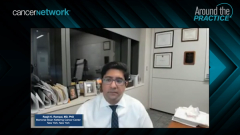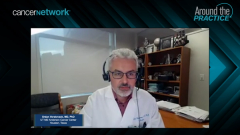
Treatment Planning and Myelofibrosis
Characteristics that contribute to treatment decisions for patients with newly diagnosed myelofibrosis
Episodes in this series

John Mascarenhas, MD: We'll move on to our next topic, myelofibrosis treatment and response monitoring. The first question here for the panelists is: How do goals of therapy vary by risk category? For example, do you treat patients with PMF [primary myelofibrosis] versus post-CT and post-PVMF [polycythemia vera and myelofibrosis] differently? How does symptom burden factor into treatment? How does cytopenia factor into treatment and how does risk score? Does the risk score really guide you on how to treat, or are you just treating based on the symptomatology at hand? I'll start, Srdan, with you. Do you distinguish between primary and post-CT post-PVMF treatment plans, or is it the treatment plan that broadly fits all 3 subtypes?
Srdan Verstovsek, MD, PhD: The treatment plan, in general, fits all 3 subtypes the same way. Apart from the prognostication that we discussed that leads me to say, who should go to transplant and who should not, I do not apply risk of dying to decide whether I should treat the patient for anemia or a weak spleen or their quality of life. The trigger is really, for me, recognition of that bad quality of life. If the spleen is big and the patient says, "I'm not in any pain," I would probably ask a few more questions. Patients may then recognize that their life did change from not having a spleen to a spleen that is about 5 inches below the costal margin on the left side. This is a slow process. Unless you ask questions, and engage with the patients, you're not going to be recognizing those problems, and patients will not be fully aware. It requires some engagement with the patients. Spending a little more time with patients with myelofibrosis to understand all the aspects of their experience is needed. That applies to post-ET [thrombocythemia], or post-PV, or primary myelofibrosis to the same degree. Although the application of therapies is different, that goes more along with what Aaron said before, that cytopenic patients, whether they are primary or secondary, should be more usually primary than secondary, are difficult to treat. They have a smaller spleen, maybe more symptoms, and more anemia and thrombocytopenia, so the therapies do differ on clinical characteristics rather than on whether it's primary or secondary or the risk of dying.
John Mascarenhas, MD: Point well taken. The point you made about the symptom burden is really important, because a lot of times, the disease can have almost an insidious onset, and patients are not always aware of their actual symptom burden, and the fatigue level, or the early satiety, the inactivity, or even bone pains. They don’t even realize it. What I found frequently is once you start treating them, particularly with JAK inhibitors, which are quite effective in ameliorating the symptom burden, I often get patients who come back and say, “I didn’t realize how poorly I felt before therapy.”One of my favorite statements is when people say, “I feel a decade younger.” They just feel much better. It’s quite satisfying as a physician to see them have that improvement. I have to say it’s pretty gratifying and instantaneous in a lot of patients, too. But it highlights the fact that a lot of patients don’t realize how to attribute the symptoms they have or the degree of symptoms sometimes that they have. Of course, as you pointed out, Srdan, you have to get an overall sense of your patient. You have to get to know the patient, get a sense of their symptom burden, their disease state, and their risk score to decide on how to best intervene in that patient. Sometimes with low-risk patients that don’t have a discernible symptom burden, one can pick a watch-and-wait approach.
I’ll ask Raajit. If you meet a low-risk myelofibrosis patient and the discussion is “Well, let’s watch you expectedly,” what does that look like? Talk the audience through when you’re watching someone for changes. What are those changes that then actually indicate the need for intervention?
Raajit K. Rampal, MD, PhD: I think [there are] a couple of points to make, both from the physician’s perspective and the patient’s perspective. When we talk about a watch-and-wait, we must be clear with the patients about what are the signs and triggers and also why are we watching and waiting? I think it's very common that patients say to us, especially when they're newly diagnosed, "Why don't we treat this? I have a diagnosis. If this was any other cancer you would treat, and why are you waiting for things to get worse?" Of course, our answer is often that we don't have a disease-modifying therapy and intervening earlier, at least we don't have any great proof that it would change anything. That being said, if we decide to take a patient on that course, it's important that we're clear about what it is we're watching for. There are a couple of ways to think about it. One, of course, is the progression in the way of symptomatic progression. That's what we've sort of just been talking about. Does somebody begin to develop the symptoms we worry about, but also that impact their quality of life maybe more importantly? Symptom, such as, the sweats, fevers, weight loss, all of those types of things. That is certainly one form of progression. Then the other things we begin to think about that would warrant intervention, is if they are starting to develop splenomegaly or hepatomegaly that is actually symptomatic or bothersome? Are they beginning to develop cytopenias? We don't have great treatments to treat cytopenias, but they are sort of a canary in the coal mine. They're a harbinger, likely of further disease progression, and we have to be attuned to that. Once those things start to happen, it's time to start thinking about a referral to stem cell transplant.Of course, we worry about progression in the form of accelerated or blast phase disease. If we start to see the blast count starting to rise again, that's another harbinger of disease progression, which may require intervention from stem cell transplanters. I think when we break it down, we have to think about the things that are triggers for treatment with current pharmacologic agents, or investigational agents, and the things that are triggers for referral to stem cell transplant.
Transcript edited for clarity.
Newsletter
Stay up to date on recent advances in the multidisciplinary approach to cancer.


















































































